Gordon Neighbour* describes TeSS, a European STEM initiative that has been remarkably successful in getting girls interested in seismology
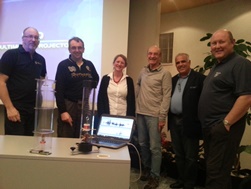 The TeSS project ‘Developing Seismology – Teaching Seismology in Schools’ is a collaborative project between four schools operating under the auspices of the EU Erasmus+ programme KA2 ‘Strategic Partnerships in Schools’ banner. The schools involved are Torquay Girls’ Grammar School, a selective state grammar school on the English Riviera (Torbay); Fulneck School, a private school based in Leeds; The Centre International de Valbonne, an international school near Nice in the south of France, and ITIS Ettore Majorana, a science-technical school based in Somma Vesuviana, Italy.
The TeSS project ‘Developing Seismology – Teaching Seismology in Schools’ is a collaborative project between four schools operating under the auspices of the EU Erasmus+ programme KA2 ‘Strategic Partnerships in Schools’ banner. The schools involved are Torquay Girls’ Grammar School, a selective state grammar school on the English Riviera (Torbay); Fulneck School, a private school based in Leeds; The Centre International de Valbonne, an international school near Nice in the south of France, and ITIS Ettore Majorana, a science-technical school based in Somma Vesuviana, Italy.
Picture: The project partners meeting at the 3rd Seismology at School meeting in Sion (Switzerland) – [also pictured: Paul Denton of BGS, whose help has been invaluable through this project].
The teaching of seismology in schools is already well established in certain countries; however, we felt that if we worked together, we could develop low-cost solutions to recording seismic data – thus allowing schools across Europe and the wider world to be able to record seismic events. The project would also allow the extension of this work to primary schools, so that students become more aware of the world around them. In addition, this project would allow the development of more cost-effective solutions for schools in the developing world.
The project also addressed the need for extending opportunities in STEM (Science, Technology, Engineering and Mathematics) subjects for all pupils. The project, using computing in schools, has developed tools that enable seismic signals to be recorded and analysed. The project also complemented and took forward the work undertaken by the project partners at ‘Seismology at School’ CPD events (in Naples, Nice and Sion) as well as the 2013 GIFT workshop at EGU.
Teaching materials
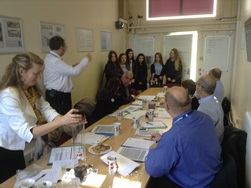 The project has involved collaborating to develop teaching materials and resources that enable the teaching of the principles of seismology, which are adaptable and transferable to schools in the developing world. A key component of the project has been to find practical ‘low-cost’ materials that can be developed for recording seismic events - especially important for developing countries, which are often sited in seismically active zones. As a further development, the project will therefore look at working with partner schools in these areas, with a view to developing their understanding of seismic risk and giving them practical tools, to take seismic readings, and so contribute to the global schools seismic network.
The project has involved collaborating to develop teaching materials and resources that enable the teaching of the principles of seismology, which are adaptable and transferable to schools in the developing world. A key component of the project has been to find practical ‘low-cost’ materials that can be developed for recording seismic events - especially important for developing countries, which are often sited in seismically active zones. As a further development, the project will therefore look at working with partner schools in these areas, with a view to developing their understanding of seismic risk and giving them practical tools, to take seismic readings, and so contribute to the global schools seismic network.
Picture: One of several planning meetings taking place at Torquay Girls’ Grammar School
The project has allowed all partner schools to set up and calibrate ‘professional’ and high-end ‘amateur’ seismometers in the schools. These are all linked into the schools seismology network and, in the case of Torquay Girls’ Grammar School, two of the four seismometers are also connected to the IRIS network.
Raspberry Pi computers have been used to develop the software to be used with the ‘home-made’ seismometers. These are still being calibrated with the ‘professional’ seismometers and their data triangulated with the project partners in both the UK and abroad.
Some project partners are now taking their seismometers into other schools, both in their own countries and to partner schools worldwide, to allow more students to benefit from the work undertaken. In the longer term, having these small portable, accurate seismometers available to schools in seismically active zones in the developing world could potentially save pupils and teaches from both earthquakes and tsunamis.
A project webpage has been constructed by each partner school, featuring its project work.
Impact
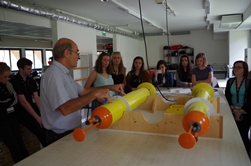 Participating students have developed a number of skills in STEM subjects that will make them more employable. It has also encouraged female students to consider a STEM career, a major impact in a known shortage area for girls. Students involved in the project will have developed vital skills in two key areas (computing and Geoscience) which should lead to improved employability for all.
Participating students have developed a number of skills in STEM subjects that will make them more employable. It has also encouraged female students to consider a STEM career, a major impact in a known shortage area for girls. Students involved in the project will have developed vital skills in two key areas (computing and Geoscience) which should lead to improved employability for all.
Picture: The students were able to visit GeoAzur which is part of the University of Nice-Sophia-Antipolis, where they were able to see the Mermaid floating seismometers
We have held four meetings to date. An initial planning meeting took place in October 2014, in Torquay. As well as introducing colleagues to the wonders of the English Riviera, it allowed colleagues to meet face-to face, often for the first time. This allowed each partner to discuss the strengths and weaknesses of the initial project bid. As with all things like this, the personal element has allowed the project as a whole to become a lot stronger.
Naples
Forty-eight students and nine teachers participated in the first student meeting in Naples in April 2015. The area was chosen to provide a very visible expression of how important geoscience is to society. The students undertook an extremely varied programme, emphasis being placed on simply getting to know one another. Far from a trivial by-product, we see this as an extremely important outcome, in our modern society where the development of a globally aware workforce is something that we are going to need - and need to get used to.
Students had the opportunity to undertake a number of visits that allowed them to see the importance of studying geosciences including Mount Vesuvius, Herculaneum, Pompeii and Solfatara. The highlight for many was the visit to the Volcano Observatory in Naples which allowed the students to see at first hand the front-line application of professional seismology and the vital relevance of the work they had been doing. This has inspired one of my students to pursue A-levels with the ultimate aim of studying geophysics at university.
Nice
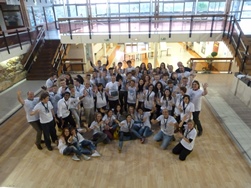 In October 2015, a further 48 students and nine teachers undertook a visit to the Centre International de Valbonne. This was very exciting for the students as a stand had been set up at the Fête de la science in Antibes, allowing some excellent ‘outreach’ activity for the project. Attendance at the event was in excess of 5000, so the project was seen by a huge variety of active scientists and laypeople.
In October 2015, a further 48 students and nine teachers undertook a visit to the Centre International de Valbonne. This was very exciting for the students as a stand had been set up at the Fête de la science in Antibes, allowing some excellent ‘outreach’ activity for the project. Attendance at the event was in excess of 5000, so the project was seen by a huge variety of active scientists and laypeople.
Picture: Students and teachers gather at the Centre International de Valbonne after the science fair to prepare for the next stages in their project.
Students were able to work collaboratively on developing their seismometers and especially on the programming for the Raspberry Pi computers. Students were also given the chance to work with professional scientists at GeoAzur (University of Nice) and to see the importance of good scientific investigation at Malpasset dam – which collapsed on December 2, 1959, killing 423 people - one of one of the worst peace-time disasters in France.
Leeds
The final student meeting provided the perfect opportunity for students show off the work they had undertaken. Presenting their work so far, they worked together with all the other students, suggesting solutions to each other’s problems. Leeds University allowed the students to develop their skills in geophysics (under the expert tutelage of Professor Jurgen Neuberg) as they engaged in trying to find the tunnels that were said to emanate from underneath Fulneck School.
At the time of writing, students still need to complete work on their seismometers. In the near future they will be set-up to take readings - and several of the schools are working with others (in their locality and further afield) to develop the schools seismometer network.
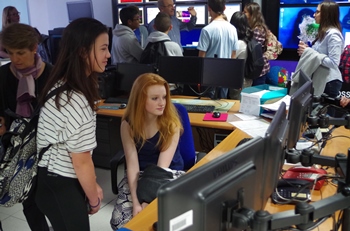 For staff, this has been an exciting opportunity to work together and to strengthen links across borders. We are now working on evaluating of the project for our final report, which is due to be submitted in August 2016.
For staff, this has been an exciting opportunity to work together and to strengthen links across borders. We are now working on evaluating of the project for our final report, which is due to be submitted in August 2016.
Picture: Seat of power: students enjoy a trip to the Volcano Observatory and see how seismology is used in monitoring the volcano. The red telephone is a direct line to the Italian President – students were told not to lift the receiver!
Acknowledgements
In closing I would like to pay tribute to all of the students who have been involved in the project and to thank the many teachers who have made this learning experience possible for such a large number. I would especially like to pass on my thanks to Dr Nicholas Smith, head teacher at Torquay Girls’ Grammar School and to Mr Robert Cross, chair of governors at Torquay Girls’ Grammar School.
As a result of this project, Torquay Girls’ Grammar School is now offering GCSE Geology from September 2016, and I would be pleased to hear from anyone who may be able to help me obtain more samples and equipment for developing the subject in the school.
Further information
If you would like to find out more about the project or European projects in general please feel free to contact me via email or visit the different project websites:
* Gordon Neighbour FGS teaches at Torquay Girls’ Grammar School, 30 Shiphay Lane, Torquay, Devon. TQ2 7DY E: [email protected]